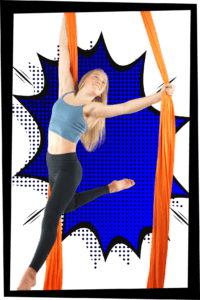Silks at Home: Why it might NOT be the Best Idea
As I sat in the gym doing “pre-hab” for my chronically tight shoulders, I overheard talk of injuries happening in other places. Students throwing moves they weren’t technically ready for on their silks at home. Students instructing other students incorrectly. Students pushing themselves outside of their current safe limits. Their intentions were all the best, of course. Then what’s the problem? Simple. They are not trained coaches.
Below is a “must read” article for anyone doing circus arts (or the parents of anyone doing circus arts). This is why continuous good instruction from a qualified and highly trained coach is critical, and why learning from friends, classmates, and YouTube on your silks at home (or trapeze, or lyra) is so incredibly dangerous. Thank you to Laura Witwar of SassyPants Aerial Arts LLC in New York for the original article!
Why not have silks at home? Well…are you a certified coach?
WHY PROGRESSIONS ARE ESSENTIAL IN AERIAL AND CIRCUS TRAINING
1. What is a Progression in CircusLand?
Simply put, a movement progression is building off of foundational skills to achieve or pursue an advanced state. For example, Lulu comes to aerial silks group class. She has never taken a silks class in her life. I do not allow or encourage her to start with a double star (duh); we work on simply standing on the fabric.
This seems pretty common sense, right? Well, I started with an easy one for you. How many of you are trying to execute a hip key in the air before mastering in-air inversions? Dear Danglers, inversions in the air come before hip keys in the air! I’ll bet you’re in bad habit city right now. Good luck with that.
Every single move in circus is built on foundations of proper body positioning, strength, and mental readiness (it’s a thing). Every. single. one. Ultimately, a progression map looks a lot like a tree: there is a solid trunk (inversion in the air), then branches start forming (hip key in the air), and so on, all the way to the fancy leaves at the end (drops from a hip key).
2. Trying to bypass those progressions is NOT PRETTY, people!
Here is what you get…
- An uphill battle. Without the supportive skills, moves higher up the progression tree are dangerous and hard. And dangerous. And frustrating. And dangerous…
- Higher risk of injuries. Not only are you more likely to fall on your head, you’re practically guaranteed repetitive stress injuries (tendinitis, bursitis, etc.), popped hamstrings, or soft tissue injuries like a torn labrum. ironic muscle pulls and strains!>
- No understanding of the theory behind it. Yes, circus theory is a thing! You should know the why behind what you’re doing. WHY do we cross two times behind the back for this move? Why do we take our heel out of the knot? Why do we “clench for Jesus” as we slide in front of the fabric? The *why* is important.
- Y’all – it’s ugly. Seriously. Know what’s lovely? A beautiful progression that doesn’t result in just heaving yourself into a position, hauling your body over, and flopping around like a deranged mackerel.
- BONUS: extra panic! And fear! A good progression also prepares you mentally for the experience of advanced moves. Some motions MUST be executed with confidence, some require some mental reconciling with fear, and some just hurt like hell. There’s no skipping the preparation for that (unless you really like falling, injury, extra pain, debilitating fear, peeing in panic, you get the picture).
3. How do I Work With Progressions?
Your coach has given a great deal of thought and preparation to their methodology and pedagogy. (Psssst! If you suspect that this is not the case, it is time to seek out a new coach.) This looks like a consistent and careful progression that is similar for every student. Everyone will progress at wildly different paces, but the stepping stones should remain the same, with small variations for special needs. It does NOT look like allowing students to jump in and try things wherever they’d like.
So there it is. This is why we love each and every one of our highly trained and certified coaches here at Akrosphere. Classes are planned out, progressions are meticulously adhered to, and our students have a huge amount of trust for us because they know we truly have their best interest at heart. And while it may occasionally frustrate someone that they don’t get to do the “cool trick” they saw somewhere, there is no “skipping steps” to try skills above an appropriate level of training for that individual. And it’s why mastery of one step is critical before moving forward to the next. Practice makes perfect, and perfect steps in a progression ensure safety and future pain-free happiness.
So, to summarize: Always work with a certified / trained professional coach who understands the value of and the creation of progressions! No coach at home? Then no silks at home.
There will be many more parts to the “Never Get Injured Again” series in the future…
Happy training, and see you in class!
Want 9 more reasons to not have aerial silks at home? Check out THIS blog post!

